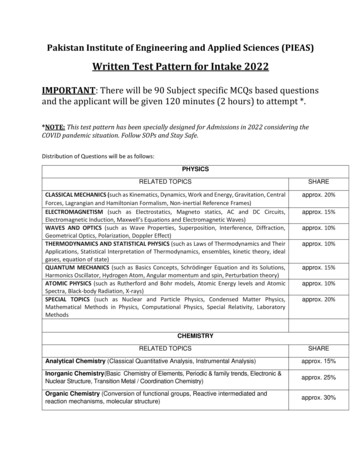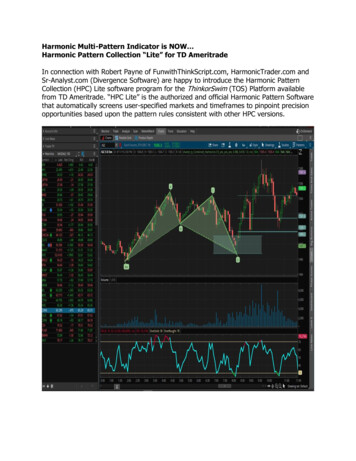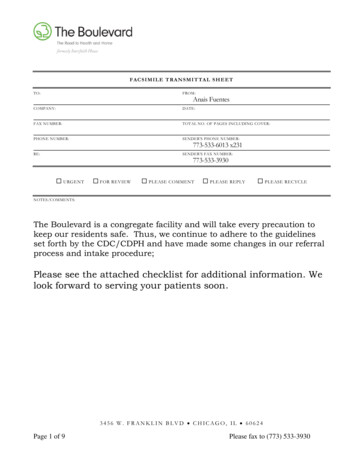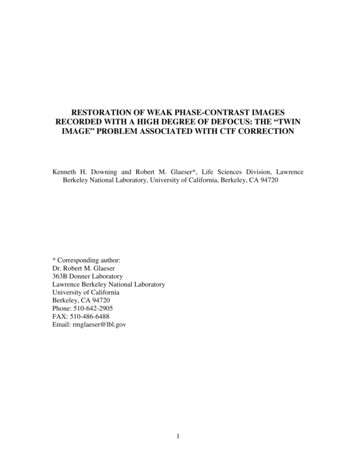
Transcription
Pakistan Institute of Engineering and Applied Sciences (PIEAS)Written Test Pattern for Intake 2022IMPORTANT: There will be 90 Subject specific MCQs based questionsand the applicant will be given 120 minutes (2 hours) to attempt *.*NOTE: This test pattern has been specially designed for Admissions in 2022 considering theCOVID pandemic situation. Follow SOPs and Stay Safe.Distribution of Questions will be as follows:PHYSICS1.1.1.1.1.1.RELATED TOPICSSHARECLASSICAL MECHANICS (such as Kinematics, Dynamics, Work and Energy, Gravitation, CentralForces, Lagrangian and Hamiltonian Formalism, Non-inertial Reference Frames)ELECTROMAGNETISM (such as Electrostatics, Magneto statics, AC and DC Circuits,Electromagnetic Induction, Maxwell’s Equations and Electromagnetic Waves)WAVES AND OPTICS (such as Wave Properties, Superposition, Interference, Diffraction,Geometrical Optics, Polarization, Doppler Effect)THERMODYNAMICS AND STATISTICAL PHYSICS (such as Laws of Thermodynamics and TheirApplications, Statistical Interpretation of Thermodynamics, ensembles, kinetic theory, idealgases, equation of state)QUANTUM MECHANICS (such as Basics Concepts, Schrödinger Equation and its Solutions,Harmonics Oscillator, Hydrogen Atom, Angular momentum and spin, Perturbation theory)ATOMIC PHYSICS (such as Rutherford and Bohr models, Atomic Energy levels and AtomicSpectra, Black-body Radiation, X-rays)SPECIAL TOPICS (such as Nuclear and Particle Physics, Condensed Matter Physics,Mathematical Methods in Physics, Computational Physics, Special Relativity, LaboratoryMethodsapprox. 20%approx. 15%approx. 10%approx. 10%approx. 15%approx. 10%approx. 20%CHEMISTRYRELATED TOPICSSHAREAnalytical Chemistry (Classical Quantitative Analysis, Instrumental Analysis)approx. 15%Inorganic Chemistry(Basic Chemistry of Elements, Periodic & family trends, Electronic &Nuclear Structure, Transition Metal / Coordination Chemistry)approx. 25%Organic Chemistry (Conversion of functional groups, Reactive intermediated andreaction mechanisms, molecular structure)approx. 30%
Physical Chemistry (General Chemistry, Classical and Statistical Thermodynamics,Quantum and Structural Chemistry, Kinetics)approx. 30%MECHANICALRELATED TOPICSSHAREMechanical Design and Anlysisapprox. 30%Kinematics, Dynamics and Vibrationapprox. 15%Materials and Manufacturingapprox. 15%Thermodynamics and Energy Convesion Processesapprox. 20%Heat Transfer, Fluid Mechanics and Hydraulic Machineryapprox. 20%ELECTRICAL ENGINEERING WITH SPECIALIZATION IN ELECTRONICSRELATED TOPICSSHAREMicroprocessors, FPGA, VLSI, DLD, etc.approx. 24%Circuit Analysis, Electronics, Process Instrumentation, Electrical Machinesapprox. 42%Controls Systems, DSP, Signals and Systems, Probability and Random Variables,Communication Systemsapprox. 34%ELECTRICAL ENGINEERING WITH SPECIALIZATION IN ELECTRICAL POWERElectrical Engineering General (Circuit Analysis, Basic Electronics, Electricity andMagnetism, Digital Logic Design, Signals and Systems, Control Systems, Measurementand Instrumentation, etc.)approx. 50%Electrical Power Specialization (High Voltage Engineering, Power System Analysis,Power System Protection, Power Generation, Power Transmission and Distribution,Power Electronics, etc.approx. 50%CHEMICALRELATED TOPICSSHAREMaterial/Energy Balances and Thermodynamics (material/energy balances; humidity;equation of state; thermodynamic properties; laws of thermodynamics; power andrefrigeration cycles; phase and reaction equilibria;)approx. 20 %Fluid Mechanics (momentum transfer; differential and integral analysis; dimensionalanalysis and similarity; pressure drop calculations; flow measurements; pumps andcompressors; compressible flows; boundary layer flows;)approx. 20 %Heat Transfer (modes of heat transfer; steady state and transient heat transfer; one-, twoand three-dimensional conduction heat transfer; conduction in series and parallel; energyequation; extended surface heat transfer; internal and external convection heat transfer;analogies; heat transfer correlations; radiation heat transfer; heat transfer equipment;)approx. 20 %
Mass transfer (molecular diffusion; mass transfer coefficient; concept of stages;distillation; absorption and stripping; liquid-liquid extraction; adsorption; ion exchange;humidification & dehumidification; selection and design of mass transfer equipment;)approx. 20 %Process dynamics/instrumentation/control (dynamic models; transfer functions; linearlow order systems; open loop stability; characteristics and calibration of instruments;control valves; classical feedback controllers; closed loop transfer functions, closed loopstability; controller tuning; feed forward, cascade, ratio, override and selective control;)approx. 10 %Reaction engineering (rate of reaction; rate law and stoichiometry; equilibriumconversion; types of reactors and reactor design; collection and analysis of reactiondata; reaction mechanism; multiple reactions; catalysis;)approx. 10 %METALLURGY/MATERIALRELATED TOPICSSHAREFerrous & Non-ferrous Metallurgy (extraction of metals, ferrous & non-ferrous alloys)approx. 15%Material Processing (fuels and furnaces, solidification & casting, powder metallurgy,welding etc.)approx. 15%Corrosion, Wear and Surface Engineering (corrosion, corrosion protection, wear, surfacehardening, coatings etc.)approx. 10%Thermodynamics & Kinetics of Phase Transformationsapprox. 10%Physical Metallurgy (metallography, microscopy, microstructure, phase diagrams, heattreatment, NDT etc.)approx. 15%Mechanical Metallurgy (elastic and plastic deformation, mechanical testing, metalforming, fracture analysis, fatigue, creep etc.)approx. 15%Engineering Materials (metals, ceramics, composites, polymers, nuclear materials,semiconductors, magnetic materials etc.)approx. 10%Materials Science (crystal structure, XRD, electrical and magnetic properties, thermalproperties, optical properties )approx. 10%COMPUTERRELATED TOPICSSHAREProgrammingapprox. 18%Operating Systemsapprox. 18%Data Structuresapprox. 18%Computer Architectureapprox. 18%Networkingapprox. 18%Others (databases, software engineering, discrete mathematics etc.)approx. 10%CIVIL
RELATED TOPICSSHAREEnvironmentalapprox. 20%Geo-Technicalapprox. 20%Structuralapprox. 20%Transportationapprox. 20%Water Resourcesapprox. 20%MECHATRONICSRELATED TOPICSSHAREBasic Mechanical Engineering10%Electrical & Electronic Engineering30%Systems Design Engineering10%Control Engineering30%Computer Engineering &Science10%Robotics and Factory Automation10%GEOLOGY / GEO PHYSICSRELATED TOPICSSHAREPlate Tectonic / EarthquakePhysical GeologyAll topics will havea share of 10 to15% in the paperStructural GeologyPetrologyMineralogyNumerical MathematicsMININGRELATED TOPICSSHAREApplied GeologyMineral Exploration and ValuationMining MethodsMine Machinery, Tools and EquipmentMine Management and Cost EconomicsRock MechanicsAll topics will havea share of 10 to15% in the paper
Explosives and BlastingChemical and Physical Processing of MineralsHealth, Safety and Environment
Pakistan Institute of Engineering and Applied Sciences (PIEAS) Written Test Pattern for Intake 2022 IMPORTANT: There will be 90 Subject specific MCQs based questions and the applicant will be given 120 minutes (2 hours) to attempt *. *NOTE: This test pattern has been specially designed for Admissions in 2022 considering the COVID pandemic .










